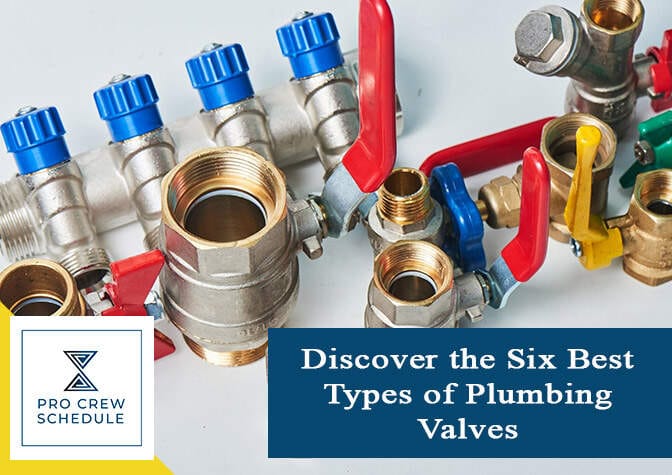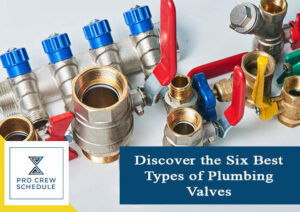Plumbing systems use various valves to control the flow of water and connect the pipes at the same time. Moreover, a wide variety of valve configurations are suitable for all conditions and services, including different utilizations, fluid control, materials, and different temperatures and pressure conditions. Plumbing valves are for preparatory and stoppage flow, throttling and regulating flow, preventing and regulating pressure, particularly in plumbing and various fluid applications. It is crucial to choose the right valve suitable for a plumbing system – a reminder for plumbers searching for the best valve that fits in with the specifications.
Let’s now begin discovering the best six types of valves used for plumbing applications.
What is Plumbing Valve?
A valve is a device that directs, regulates, and controls fluid flow by closing, opening, or partially obstructing fluid flow. It might sound somehow complicated, but to simplify it, a valve is a mechanical device used to control fluid pressure and flow within a process or a system. That is why it valves a crucial part in most plumbing projects.
Valves can range from ordinary valves mostly located near a water meter to individual fixture shutoff valves located on the feed faucets’ supply lines. It varies in size; however, the materials used for this item are also taken into consideration. Selecting the best valve suitable for a plumbing system is not the only thing plumbers are focusing on. Like every professional laborer, they manage tasks and various plumbing projects and the only way to fully supervise the project is to invest in advanced project management tools.
Best Types of Plumbing Valves
Most of the valves used today are available in different materials, including brass, bronze, and PVC plastic. Make sure to select the type of pipe that is specifically used for plumbing systems. Here are the seven types of plumbing types.
1. Globe Valve
Globe valve is commonly used to start, regulate, and stop the flow of fluids. This type of valve is explicitly used for systems where leak tightness is necessary, and flow control is highly-suggested. Globe valve can provide better shut off compare to gate valves. These valves are installed when the water flow must be regulated or needed some immediate adjustments. The interior design features of this valve contain a stopper on both ends.
Because glove valves are often suitable for regulating flow, they are preferably used for outdoor faucets or other similar utility faucets. Y types, Z types, and Angle types are some typical sorts of globe valves. Also, in terms of the price, it can be costly, depending on the materials used.
2. Gate Valve
Among the most typically used valves when it comes to plumbing applications, gate valves are the leading option. This type of valve controls the flow of water by lowering and raising a particular internal gate using a twist-type knob or handle. The knob is located at the top of the valve, and it must never be used to control the flow volume. Take note that these plumbing valves are designed to be completely open and closed. Opening it lets a full flow impact, and closing it is to stop the flow entirely.
There are five standard gate valves available for use today:
· Flexible wedge gate valve
· Solid wedge gate valve
· Rising Stem valve and OS & Y Gate valve
· Parallel disks valve or Split wedge
3. Butterfly Valve
Butterfly valves have a mere resemblance to ball valves because they both have a lever-type handle that closes and opens the valve itself. The design utilizes a metal disc that switches the flow of water. The water is at the center of the valve, flowing around the disc, and the flow is somewhat reduced even though the valve is fully open. Compare to ball valves. A butterfly valve can accurately adjust the volume of the flow.
One noticeable drawback of a butterfly valve is its gasket inside. It can cause some maintenance issues after a couple of years.
4. Check Valve
Check valves are typically used for the flow control in water tanks and can operate automatically. It was made to keep water from flowing in one direction. A non-return valve is another term used for the check valve because it can prevent back-flow within the piping system. Most of these valves are spring-loaded for faster operations. Here are some common types of a check valve:
· Piston check valve – spring and piston checks cease a reversing flow using a spring-loaded plunger.
· Swing check valve – wafer and swing checks often cease a reversing flow within a flap. The flaps swing onto a seat. For swing checks, it is used only for a forwarding flow; either it is vertical or horizontal upward.
· Ball check valve – this check valve has a ball that often slides directly into a hole as the flow tends to be slower. A ball-check is highly suggested for semi-fluids like pulp or effluent.
5. Needle Valve
These valves are quite more similar to a globe valve in terms of design. However, the only significant difference between these two valves is the sharp needle-like disk. This type of valve is designed to provide precise and detailed control of flow within piping systems with a smaller diameter. The name of this valve is derived from its sharp and pointed conical disc and matching seats.
The closing shaft of this valve functions as a plug with small openings. Ideally, it is used more for regulating the flow of water. The precision, design and stability of the valve provide an excellent seal despite the immense contrasts between pressures. It is used as a standard bypass to the ball valve for a hydraulic sector before turbines.
6. Pressure-Reducing Valve
In order to minimize the total water pressure in the plumbing system, water pressure-reducing valves are preferably installed. The valve itself has a diaphragm and spring adjusted to a particular limit, depending on water pressure. It is also not used to close or open the water flow but rather adjust it to lessen overall water pressure.
These valves are generally used in residential settings that often received high-pressure water directly from the municipal water supply. The municipal water supply pressure is sufficient to destruct a residential plumbing system and even home appliances.
Five Critical Factors to Consider in Plumbing Valve Selection
For plumbers, valves’ selection is often based on the rationality of every operation, safety, and the experience result of a detailed and comprehensive balance comparison. Also, selecting project management software as an important tool for monitoring and tracking any plumbing projects is considered advantageous.
Furthermore, it is crucial to look at some critical factors to ensure you choose the right plumbing valve from various options available today.
1. Media Type
The characteristics of the liquid type being controlled will identify the valve material that must be used. When tracking corrosive and harsh materials, PRFE and PFA are great options to withstand and endure these extreme conditions. When tracking pressurized gases, it is vital to use metal valves to obtain the highest safety level.
2. Valve function
Identify first what the valve needs to fill in. Apparently, two-way valves usually perform very well when it comes to on/off control within a system. The three-way valves are a great option also on/off control like mixing and diverting media. Additionally, be mindful of whether the valve is open or close because it can’t be the other way around. To prolong these valves’ life expectancy, make sure to order valves made from high-quality materials and within an orientation.
3. Application Conditions
Getting the correct valve sizing is one of the most critical steps in choosing the right valve application. An improperly sized valve tends to cause some operational issues within the system or elsewhere. Additionally, make sure to identify the flow rate, temperature, and pressure that these valves will be operating under. In many cases, globe valves can withstand higher pressure and temperatures compared to plastic ones.
4. Actuation Method
Another factor to consider is how the valve should be properly be operated. Determine if the valves are manually operated, or it needs to be actuated to turn on and off automatically. If you choose the latter, make sure to decide the units to be used. It should be partnered with a hydraulic, electric, and pneumatic actuator.
5. Pressure Class
In many cases, a valve’s pressure is commonly given by default by the defined pressure class. Otherwise, the used valve’s pressure class might be the outcome of the combined pressure, bonnet materials used and temperature. Moreover, it is one of the essential elements a plumber or a buyer should not miss. The selection of construction material for this valve often relies on the medium. Ensure the compatibility of pressure class and the material used for the medium.
How can Plumbers be helped by using Crew Schedule Software?
From receiving and providing accurate data to finishing projects within the budget and on time, modern software technologies can streamline every process involved while expanding the profitability and project success. Plumbing professionals and their next bigger projects can be efficiently managed using such software. For as long as construction crew management is implemented as well, every participating plumber is well-monitored.
Below are the excellent features of this software application that simplify project management:
· Easy access for data and files
· Manage time, crew, and track labor hours
· Real-time Team collaboration
· Cloud-based storage and features
· Managing construction projects with proficiency
Key Takeaways
The list includes various popular types of valves commonly used for plumbing applications, yet it is far from exhaustive. Basically, the right valve for you will largely depend on the application. Ensure to consider the highlighted essential factors before selecting the best plumbing. Get wiser and be more practical in choosing!







